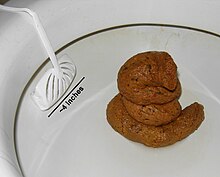| Revision as of 23:58, 3 October 2006 view sourceTrevor MacInnis (talk | contribs)Extended confirmed users74,493 editsm Reverted edits by 71.225.9.197 (talk) to last version by Dyllanisawesome← Previous edit | Revision as of 01:14, 4 October 2006 view source 24.21.239.133 (talk)No edit summaryNext edit → | ||
| Line 6: | Line 6: | ||
| Some animal feces are used as fuel. | Some animal feces are used as fuel. | ||
| hey sry im doing this but wat is ure name | |||
| again kasafias? | |||
| == Related terminology == | == Related terminology == | ||
Revision as of 01:14, 4 October 2006
Feces, faeces, or fæces (see spelling differences) is waste product from an animal's digestive system tract expelled through the anus (or cloaca) during defecation. In humans, defecation may occur (depending on the individual and the circumstances) from once every two or three days to several times a day. Hardening of the feces may cause prolonged interruption in the routine and is called constipation. The word faeces is the plural of the Latin word fæx meaning "dregs". There is no singular form in the English language .
The distinctive odor of feces is due to bacterial action. Bacteria produce compounds such as indole, skatole, and thiols (sulfur containing compounds), as well as the inorganic gas hydrogen sulfide. These are the same compounds that are responsible for the odor of flatulence. Consumption of foods with spices may result in the spices being undigested and adding to the odor of feces. Certain commercial products exist that can reduce the odor of feces.
The feces of animals is often used as fertilizer; see manure. Some animal feces are used as fuel.
Related terminology
Scatology is the study of feces. Informally, the words "excrement," "crap," and "poop" have become synonymous with feces. The word "shit," which is not slang but is historically the basic word for feces in English, is now considered vulgar.
Coprophilia, also known as fecophilia, is a sexual attraction to fecal matter. Coprophobia, also known as fecophobia, is a strong fear of feces or human excrement in general.
A coprolite is fossilized feces.
Human feces
Main article: Human feces
Human fecal matter varies significantly in appearance, depending on diet and health. Normally it is semisolid, with a mucus coating. Its brown coloration comes from a combination of bile and bilirubin, which come from dead red blood cells. In newborn babies, fecal matter is initially yellow/green after the meconium. This coloration comes from the presence of bile alone. In time, as the body starts expelling bilirubin from dead red blood cells, it acquires its familiar brown appearance, unless the baby is breast feeding, in which case it remains soft, pale yellowish, and not-unpleasantly scented until the baby begins to eat significant amounts of other food. Throughout the life of an ordinary human, one may experience many types of feces. A "green" stool is from rapid transit of feces through the intestines, and "clay-like" appearance to the feces is the result of a lack of bilirubin. Bile overload is very rare, and not a health threat. Problems as simple as serious diarrhea can cause blood in one's stool, turning it black. Food may sometimes make an appearance in the feces. Common undigested foods found in human feces are seeds, nuts, corn and beans, mainly because of their high fiber content. Consistency and shape of stools may be simply classified medically according to the Bristol Stool Scale.
External links and references
- A FAQ site on poop
- Short but detailed biological explanation of why feces are brown
- Liver biochemistry
- History of Shit by Dominique Laporte. ISBN 0-262-62160-6
- MedFriendly's Article on Feces